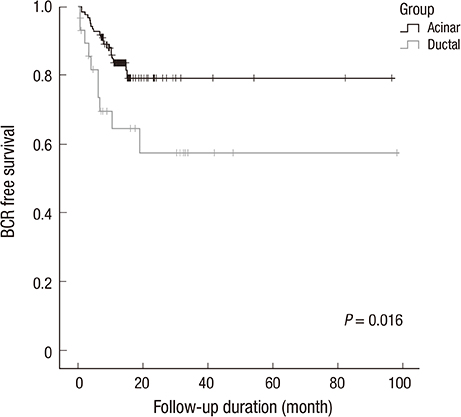J Korean Med Sci.
2015 Apr;30(4):385-389. 10.3346/jkms.2015.30.4.385.
Clinicopathological Features of Prostate Ductal Carcinoma: Matching Analysis and Comparison with Prostate Acinar Carcinoma
- Affiliations
-
- 1Department of Urology, Asan Medical Center, University of Ulsan College of Medicine, Seoul, Korea. cskim@amc.seoul.kr
- 2Department of Pathology, Asan Medical Center, University of Ulsan College of Medicine, Seoul, Korea.
- KMID: 2164445
- DOI: http://doi.org/10.3346/jkms.2015.30.4.385
Abstract
- We evaluated the clinicopathological features and prognosis of 29 cases of prostate ductal carcinoma was considered to be an aggressive subtype of prostate acinar carcinoma. We selected 29 cases who were diagnosed prostate ductal carcinoma and had a radical prostatectomy (RP). The acinar group (n = 116) was selected among 3,980 patients who underwent a prostatectomy. The acinar group was matched to the ductal group for prostate specific antigen (PSA), clinical stage, Gleason score, and age. The mean (range) of the follow-up periods for the ductal and acinar group was 23.8 +/- 20.6 and 58 +/- 10.5 months, respectively. The mean age of the prostate ductal and acinar carcinoma patients was 67.3 and 67.0 yr and the mean PSA level was 14.7 and 16.2 ng/mL, respectively. No statistical differences were evident between groups in terms of the final pathologic stage or positive resection margin rate other than the postoperative Gleason score. A greater proportion of the ductal group demonstrated a postoperative Gleason score > or = 8 in comparison with the acinar group (P = 0.024). Additionally, we observed significant prognostic difference in our patient series in biochemical recurrence. The ductal group showed a poorer prognosis than the acinar group (P = 0.016). There were no differences significantly in terms of final pathology and rate of positive resection margin, but a greater proportion of the ductal group demonstrated a Gleason score > or = 8 than the acinar group after matching for PSA, Gleason score in biopsy and clinical stage. The ductal group also showed a poorer prognosis.
MeSH Terms
Figure
Reference
-
1. Dube VE, Farrow GM, Greene LF. Prostatic adenocarcinoma of ductal origin. Cancer. 1973; 32:402–409.2. Greene LF, Farrow GM, Ravits JM, Tomera FM. Prostatic adenocarcinoma of ductal origin. J Urol. 1979; 121:303–305.3. Epstein JI, Woodruff JM. Adenocarcinoma of the prostate with endometrioid features. A light microscopic and immunohistochemical study of ten cases. Cancer. 1986; 57:111–119.4. Amin A, Epstein JI. Pathologic stage of prostatic ductal adenocarcinoma at radical prostatectomy: effect of percentage of the ductal component and associated grade of acinar adenocarcinoma. Am J Surg Pathol. 2011; 35:615–619.5. Sanati S, Watson MA, Salavaggione AL, Humphrey PA. Gene expression profiles of ductal versus acinar adenocarcinoma of the prostate. Mod Pathol. 2009; 22:1273–1279.6. Epstein JI. An update of the Gleason grading system. J Urol. 2010; 183:433–440.7. Bostwick DG, Kindrachuk RW, Rouse RV. Prostatic adenocarcinoma with endometrioid features. Clinical, pathologic, and ultrastructural findings. Am J Surg Pathol. 1985; 9:595–609.8. Brinker DA, Potter SR, Epstein JI. Ductal adenocarcinoma of the prostate diagnosed on needle biopsy: correlation with clinical and radical prostatectomy findings and progression. Am J Surg Pathol. 1999; 23:1471–1479.9. Seipel AH, Wiklund F, Wiklund NP, Egevad L. Histopathological features of ductal adenocarcinoma of the prostate in 1,051 radical prostatectomy specimens. Virchows Arch. 2013; 462:429–436.10. Lee TK, Miller JS, Epstein JI. Rare histological patterns of prostatic ductal adenocarcinoma. Pathology. 2010; 42:319–324.11. Tu SM, Lopez A, Leibovici D, Bilen MA, Evliyaoglu F, Aparicio A, Guo CC, Kuban DA, Johnson MM, Pisters LL. Ductal adenocarcinoma of the prostate: clinical features and implications after local therapy. Cancer. 2009; 115:2872–2880.12. Orihuela E, Green JM. Ductal prostate cancer: contemporary management and outcomes. Urol Oncol. 2008; 26:368–371.13. Humphrey PA. Histological variants of prostatic carcinoma and their significance. Histopathology. 2012; 60:59–74.14. Guo CC, Epstein JI. Intraductal carcinoma of the prostate on needle biopsy: Histologic features and clinical significance. Mod Pathol. 2006; 19:1528–1535.15. Robinson BD, Epstein JI. Intraductal carcinoma of the prostate without invasive carcinoma on needle biopsy: emphasis on radical prostatectomy findings. J Urol. 2010; 184:1328–1333.16. Cohen RJ, Wheeler TM, Bonkhoff H, Rubin MA. A proposal on the identification, histologic reporting, and implications of intraductal prostatic carcinoma. Arch Pathol Lab Med. 2007; 131:1103–1109.17. Merchant RF Jr, Graham AR, Bucher WC Jr, Parker DA. Endometrial carcinoma of prostatic utricle with osseous metastases. Urology. 1976; 8:169–173.18. Ro JY, Ayala AG, Wishnow KI, Ordóñez NG. Prostatic duct adenocarcinoma with endometrioid features: immunohistochemical and electron microscopic study. Semin Diagn Pathol. 1988; 5:301–311.19. Jardel P, Debiais C, Godet J, Irani J, Fromont G. Ductal carcinoma of the prostate shows a different immunophenotype from high grade acinar cancer. Histopathology. 2013; 63:57–63.20. Meeks JJ, Zhao LC, Cashy J, Kundu S. Incidence and outcomes of ductal carcinoma of the prostate in the USA: analysis of data from the Surveillance, Epidemiology, and End Results program. BJU Int. 2012; 109:831–834.


